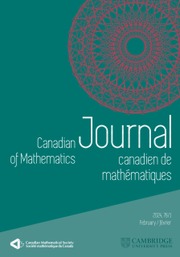Crossref Citations
This article has been cited by the following publications. This list is generated based on data provided by
Crossref.
Srivastava, H.M
Shen, C.Y
and
Owa, Shigeyoshi
1989.
A linear fractional calculus operator and its applications to certain subclasses of analytic functions.
Journal of Mathematical Analysis and Applications,
Vol. 143,
Issue. 1,
p.
138.
Owa, Shigeyoshi
and
Srivastava, H. M.
1990.
An application of a certain fractional derivative operator.
Proceedings of the Japan Academy, Series A, Mathematical Sciences,
Vol. 66,
Issue. 10,
Srivastava, H.M.
and
Owa, Shigeyoshi
1991.
Certain subclasses of starlike functions, I.
Journal of Mathematical Analysis and Applications,
Vol. 161,
Issue. 2,
p.
405.
Srivastava, H.M.
and
Owa, Shigeyoshi
1991.
Certain subclasses of starlike functions, II.
Journal of Mathematical Analysis and Applications,
Vol. 161,
Issue. 2,
p.
416.
Kim, Yong Chan
Lee, Kyung Suk
and
Srivastava, H. M.
1992.
Certain classes of integral operators associated with the hardy space of analytic functions.
Complex Variables, Theory and Application: An International Journal,
Vol. 20,
Issue. 1-4,
p.
1.
Altintaş, O.
Irmak, H.
and
Srivastava, H.M.
1995.
A subclass of analytic functions defined by using certain operators of fractional calculus.
Computers & Mathematics with Applications,
Vol. 30,
Issue. 1,
p.
1.
Chen, Ming-Po
Irmak, Hüseyin
and
Srivastava, H.M
1997.
Some Families of Multivalently Analytic Functions with Negative Coefficients.
Journal of Mathematical Analysis and Applications,
Vol. 214,
Issue. 2,
p.
674.
Raina, R.K.
1997.
On certain classes of analytic functions and applications to fractional calculus operators.
Integral Transforms and Special Functions,
Vol. 5,
Issue. 3-4,
p.
247.
Chen, Ming-Po
Srivastava, H.M.
and
Yu, Ching-Shu
1998.
Some operators of fractional calculus and their applications involving a novel class of analytic functions.
Applied Mathematics and Computation,
Vol. 91,
Issue. 2-3,
p.
285.
Chen, Ming-Po
Irmak, H.
and
Srivastava, H.M.
1998.
A certain subclass of analytic functions involving operators of fractional calculus.
Computers & Mathematics with Applications,
Vol. 35,
Issue. 5,
p.
83.
Kulkarni, S.R.
Naik, U.H.
and
Srivastava, H.M.
1999.
An application of fractional calculus to a new class of multivalent functions with negative coefficients.
Computers & Mathematics with Applications,
Vol. 38,
Issue. 5-6,
p.
169.
Srivastava, H. M.
1999.
Analytic and Geometric Inequalities and Applications.
p.
349.
Srivastava, H.M.
and
Mishra, A.K.
2000.
Applications of fractional calculus to parabolic starlike and uniformly convex functions.
Computers & Mathematics with Applications,
Vol. 39,
Issue. 3-4,
p.
57.
Srivastava, H.M.
and
Saxena, R.K.
2001.
Operators of fractional integration and their applications.
Applied Mathematics and Computation,
Vol. 118,
Issue. 1,
p.
1.
Choi, Jae Ho
Saigo, Megumi
and
Srivastava, H.M.
2002.
Some inclusion properties of a certain family of integral operators.
Journal of Mathematical Analysis and Applications,
Vol. 276,
Issue. 1,
p.
432.
Gangadharan, A.
Shanmugam, T.N.
and
Srivastava, H.M.
2002.
Generalized hypergeometric functions associated with k-uniformly convex functions.
Computers & Mathematics with Applications,
Vol. 44,
Issue. 12,
p.
1515.
Dziok, J.
and
Srivastava, H. M.
2003.
Certain Subclasses of Analytic Functions Associated with the Generalized Hypergeometric Function.
Integral Transforms and Special Functions,
Vol. 14,
Issue. 1,
p.
7.
Owa *, Shigeyoshi
and
Srivastava, H. M.
2004.
Some subordination theorems involving a certain family of integral operators.
Integral Transforms and Special Functions,
Vol. 15,
Issue. 5,
p.
445.
Liu, Jin-Lin
and
Srivastava, H.M.
2004.
Certain properties of the Dziok–Srivastava operator.
Applied Mathematics and Computation,
Vol. 159,
Issue. 2,
p.
485.
Güney, H. Özlem
Eker, S. Sümer
and
Owa, Shigeyoshi
2006.
FRACTIONAL CALCULUS AND SOME PROPERTIES OF $k$-UNIFORM CONVEX FUNCTIONS WITH NEGATIVE COEFFICIENTS.
Taiwanese Journal of Mathematics,
Vol. 10,
Issue. 6,
 if it never takes on the same value twice, that is, if f(z 1) = f(z 2) for
if it never takes on the same value twice, that is, if f(z 1) = f(z 2) for  implies that z 1 = z 2. A set
implies that z 1 = z 2. A set  is said to be starlike with respect to
is said to be starlike with respect to  the line segment joining w 0 to every other point
the line segment joining w 0 to every other point  lies entirely in
lies entirely in  . If a function f(z) maps
. If a function f(z) maps  onto a domain that is starlike with respect to w 0, then f(z) is said to be starlike with respect to w 0. In particular, if w 0 is the origin, then we say that f(z) is a starlike function. Further, a set
onto a domain that is starlike with respect to w 0, then f(z) is said to be starlike with respect to w 0. In particular, if w 0 is the origin, then we say that f(z) is a starlike function. Further, a set  is said to be convex if the line segment joining any two points of
is said to be convex if the line segment joining any two points of  lies entirely in
lies entirely in  . If a function f(z) maps
. If a function f(z) maps  onto a convex domain, then we say that f(z) is a convex function in
onto a convex domain, then we say that f(z) is a convex function in  .
.
